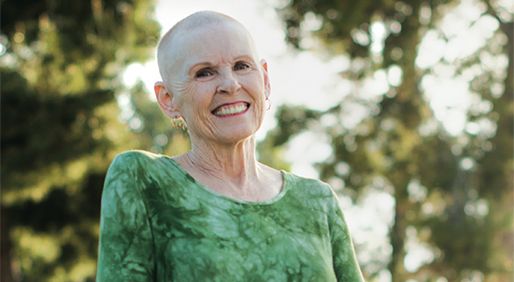Publication
Article
CURE
Life, Redefined: Living Well With Metastatic Cancer
Author(s):
Living well with metastatic cancer means finding ways to accept the diagnoses and continue to move forward.
SHIRLEY MERTZ, president of the Metastatic Breast Cancer Network, makes two lists before undergoing follow-up scans: what she’ll do if she gets bad news and what she’ll do if the news is good. “Am I finally going to take that trip to Hawaii?” she asks.- COURTESY SHIRLEY MERTZ

SHIRLEY MERTZ, president of the Metastatic Breast Cancer Network, makes two lists before undergoing follow-up scans: what she’ll do if she gets bad news and what she’ll do if the news is good. “Am I finally going to take that trip to Hawaii?” she asks.- COURTESY SHIRLEY MERTZ
If you watch any older movie that involves a character being diagnosed with stage 4 cancer, the question that invariably follows is, “How long have I got, Doc?”
Until very recently, the words “metastatic cancer” translated as “terminal.”
While median survival rates for stage 4 cancers are still staggeringly lower than those associated with earlier stages, a growing list of cancers can be treated with newer drugs, and the outlook for better longevity for patients with metastatic cancer is growing more hopeful by the day.
John Marshall, M.D., chief of oncology and hematology at Georgetown University Medical Center and director of the Ruesch Center for the Cure of Gastrointestinal Cancers, both in Washington, D.C., says that advances in treatment, combined with our increased access to information, has transformed the conversation. “Just a few years ago, a patient with metastatic disease would ask, ‘Is there anything you can do for me?’ Now, the question is, ‘What’s next?’” he relates.
Patients with certain types of metastatic cancer, such as prostate cancer, multiple myeloma and certain subtypes of lung and breast cancer, can live for years, even decades, with the help of treatments that either keep disease stable or eradicate it altogether. As such, people have started to use terms like “chronic illness” and “manageable.”
Marshall says that he always told his patients, “Just stick around long enough, and maybe we’ll get smarter.” Though he has always meant this, Marshall says it wasn’t until recently that he actually saw it happening.
“We’ve created a new kind of patient — the stage 4 N.E.D. (no evidence of disease),” he says, “and are faced with a good problem: figuring out how to take care of someone dealing with the longterm impacts of metastatic cancer.”
LIVING WITH UNCERTAINTY
Some patients and practitioners find it frustrating to hear about cancers being treated as chronic diseases, since each type of cancer can include many subtypes, some less likely than others to respond to treatment.
Published statistics about survival rates for metastatic cancers can be discouraging, but it’s important to remember that these do not reflect the rapid progress being made in treatment.
The successes of newer treatments being tested in clinical trials are not included in these numbers, and most targeted drugs and immunotherapies that are approved by the Food and Drug Administration (FDA) to treat cancer are so new that 10-year survival rates have yet to be tabulated.
Shirley Mertz, president of the Metastatic Breast Cancer Network, has been living with metastatic breast cancer since 2003, and likes to remind herself that statistics won’t necessarily dictate her own experience. “I have lost many friends to this disease. Their deaths remind me of the reality that, at any point, my disease can progress and resist treatment,” she says. “I fight back the fear by reminding myself that I am a statistic of one.”
SANDRA SPIVEY has been living with metastatic breast cancer for nearly 20 years, and tries not to let treatment interfere with special experiences, such as trips with her sisters.- KRISTIANNE KOCH RIDDLE

SANDRA SPIVEY has been living with metastatic breast cancer for nearly 20 years, and tries not to let treatment interfere with special experiences, such as trips with her sisters.- KRISTIANNE KOCH RIDDLE
Sandra Spivey, whose breast cancer became metastatic in 1998, takes a similar view. At the time, she researched her prognosis and found a median two-year survival rate of 30 percent and a fiveyear survival rate of 10 percent. “Well, the number isn’t zero,” thought Spivey. “People are living with this disease. Why can’t I be one of those people?”
No matter how hopeful or dire someone’s prognosis is, living with metastatic cancer typically does mean that ongoing treatment and/or surveillance will become a regular part of life. Still, it doesn’t have to be the most important part, experts point out.
Maggie Compernolle, RN, a nurse in the Oncology Department at Barnes- Jewish Hospital in St. Louis, Missouri, says she has seen patients with metastatic cancer fare better when they don’t define themselves by their cancer, but rather allow it to be part of who they are and not all of who they are.
“Imagine life as a river,” she suggests. “Cancer is this force that comes flooding into that river at a 90-degree angle. People who do not allow the cancer to slightly change their river’s course wind up swimming against the current, which is unnecessarily exhausting.”
Mertz, who has been N.E.D. since 2014, has created tactics that help her prevail over anxiety, especially around scan time. While she used to make a list of things she needed to do if she got bad news, “I now make two lists, to include what I’m going to do if I get good news,” she says. “Am I going to buy tickets to that upcoming Yo-Yo Ma concert? Am I finally going to take that trip to Hawaii?” Nearly 20 years after her diagnosis, Spivey is still undergoing treatment, but she tries her best not to let it interfere with her pursuit of the things that make her happy. She likes to plan joyful events as mile markers to look forward to, and has taken several trips with her sisters, including a three-week adventure tour to Vietnam. “While traveling, I always give myself extra time to do things and don’t push myself to the point of exhaustion,” she says. “I always buy travel insurance, and make sure it’s a plan that includes pre-existing conditions.” “If something you really want to do conflicts with your treatment schedule,” she advises, “don’t be afraid to ask your doctor to postpone a treatment or reorganize your schedule to accommodate your plans.”
SEEKING SUPPORT
Spivey and Mertz agree that finding support, both from mental health professionals and other patients with metastatic cancer, has been critical to their emotional well-being. However, support groups specifically for stage 4 patients are difficult to find.
Mertz says it took her almost two years to connect with another patient with metastasis after her late-stage diagnosis. “I was told that patients with metastatic disease weren’t welcome in early-stage support groups,” she says, “because we were seen as downers.”
Even if they are welcome, patients with metastatic cancer may experience a sense of alienation in these groups. “Nobody wants to be seen as the one person who takes away the hope of the others,” says social worker Yvette Colón, Ph.D., M.S.W., ACSW, BCD, psychosocial coordinator for the MetaCancer Foundation, which supports patients with late-stage cancers and their caregivers. “Also, patients with metastatic cancer have a different set of needs than patients with earlier-stage disease. There is a greater prevalence of distress.”
Through focus groups and surveys, the MetaCancer Foundation found that a majority of patients with stage 4 cancer want to connect with others who have metastatic disease, believing they have more in common with these patients than with others who have the same type of cancer, but at an earlier stage.
STAYING PHYSICALLY STRONG
Since having metastatic cancer often means perpetually undergoing treatment, which can result in both physical limitations and pain, integrative therapies are often recommended to help patients feel better physically and emotionally during and after treatment.
Sami Mansfield — founder of Cancer Wellness for Life, a company that helps integrate exercise into the lives of patients with cancer — maintains that changes in nutrition and exercise should ideally be addressed pre-treatment. “When a person is diagnosed with metastatic cancer, they know that the surgery or treatment is coming. We need to help patients beef up before the treatment so that they can better tolerate it. If you’re going to climb Kilimanjaro, you train for it.”
Mansfield hopes to see the cancer community shift away from the “onesize- fits-all” nature of how supportive therapies are offered. “We need to ask patients, ‘What are your goals?’ What are your side effects? What does your life look like?’ and then provide a menu that a patient can choose from, instead of assigning supportive therapies under the umbrella of a person’s diagnosis,” Mansfield says. “The medical piece is often about the red lights, what a patient can’t do, so supportive therapies need to be about the green lights.”
Spivey has incorporated yoga, walking and acupuncture into her life, and these practices have helped to ease the unpleasant side effects of neuropathy, edema and urinary tract infections. When asked what advice she would give to patients newly diagnosed with metastatic cancer, Spivey says, “With cancer, yes, part of your body isn’t healthy, but maybe the rest of your body is. Stay as healthy as possible, so that you can be stronger for treatments and feel better mentally.”
CONSIDERING THE END OF LIFE
Many don’t realize that, even for patients who have responded well to treatment, fear of death is always looming. It’s essential, experts say, for patients and their loved ones to face that fear in order to move forward with a healthier mental state. Having a clear picture of how they want the ends of their lives to look can relieve pressure and allow patients to better enjoy the time they do have. Colón stresses how critical it is for patients to have direct conversations with loved ones and be proactive in making advanced directives. “Facing our mortality can seem psychologically threatening, but ignoring it increases anxiety,” she says. “When people don’t address these issues, they can reach the ends of their lives with a lot of unfinished business, both financially and emotionally.”
Compernolle believes that acceptance plays a big part in allowing patients to move forward. “Accepting that you have a terminal illness doesn’t mean that you like it,” she points out. But what happens when the end of life draws nearer — when treatment options run out, or when someone can no longer tolerate the toxicity of treatment? Compernolle says that the medical community needs to learn to really listen to patients and respect their decisions. “I’ve heard patients use the phrases “how to die” and “how to live” in the same breath — these terms can be used interchangeably when someone receives the news that their cancer is imminently terminal,” Compernolle says, adding that many patients facing the end of life want to die in the comfort of their own homes, surrounded by loved ones, instead of in a hospital.
Unfortunately, patients who believe it’s time to opt out of further treatment can feel guilt and anxiety about that decision because those around them, even sometimes their oncologists, may feel that they are giving up.
“The one thing in your life you should have control over is how you want the end of your life to look,” Compernolle says, “and the people around you need to respect that.”





